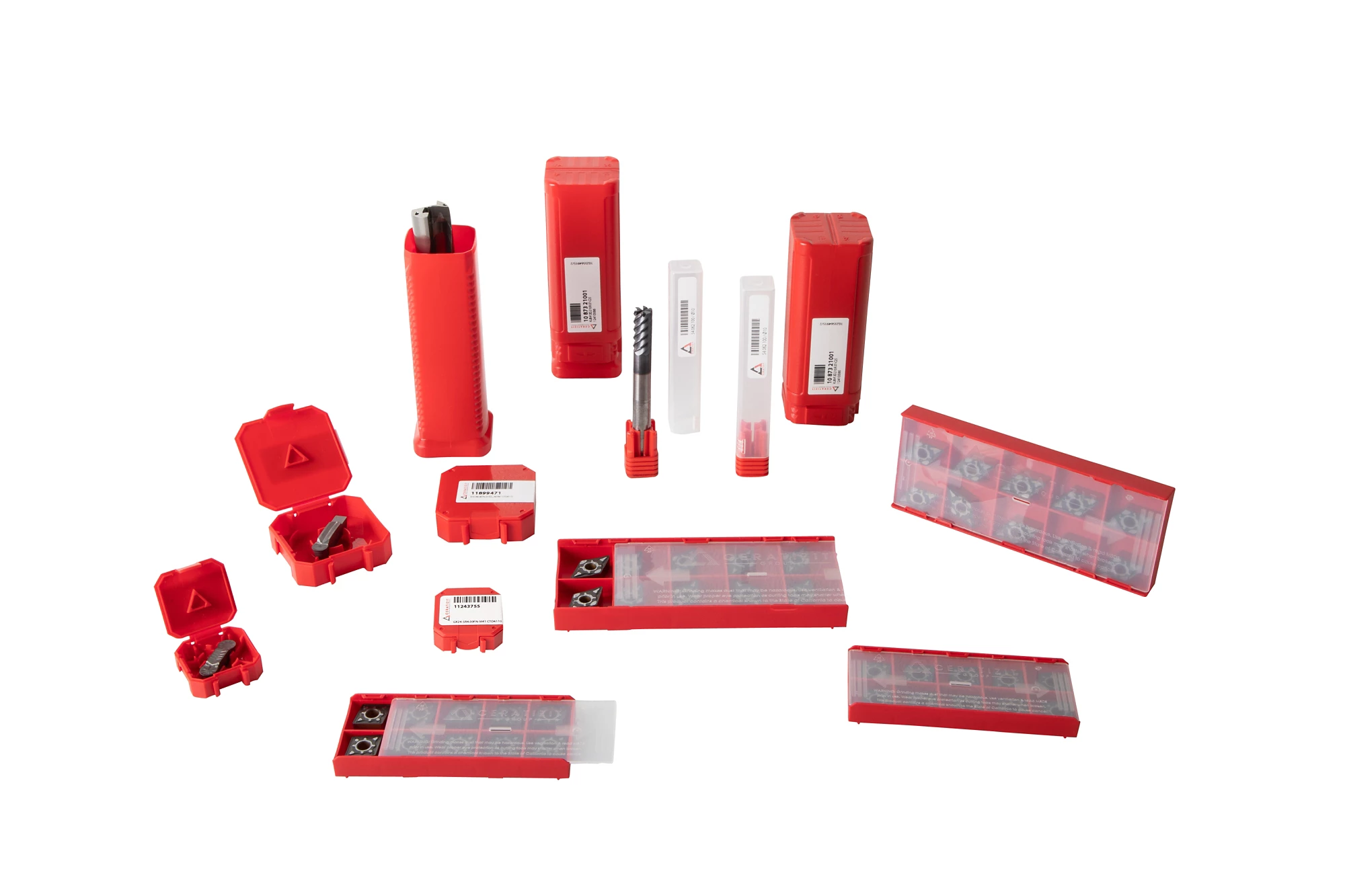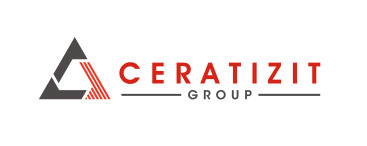January 17, 2024
We'll be sure to secure it! Sustainable packaging helps to reduce CO2

Simon Bleiholder (left) and Jürgen Duwe
Plastic packaging is a firm component of our every day life. Even our high-quality tools require protection on a journey. Simon Bleiholder pursued how such packaging can be made sustainable within the framework of his Bachelor dissertation. The result: packaging that is even manufactured from 100% recycled material and, as a result, saves a huge amount of CO2. In the interview, Simon Bleiholder and Jürgen Duwe told us about this project.
Simon, how did arrive at your BA topic “Assessment and Generation of a Concept for the Sustainable Packaging of Indexable Inserts”?
I studied Industrial Mechanical Engineering at the Kempten University of Applied Sciences. In the fifth semester I completed my practical semester with a company that manufactured machines for the packaging industry, primarily for the food industry and medical technology. Because I was already familiar with CERATIZIT from my apprenticeship, I immediately looked at job advertisements when researching for my Bachelor dissertation – and then I came across the job advert for the packaging concept.
The aim of my Bachelor dissertation was to assess and create a concept for the sustainable packing of PKD ISO turning indexable inserts for alloy wheel processing. In doing this, the recyclability of packaging was right at the forefront. The goal was to find a sustainable packaging material with which the packaging could stay in the cycle of materials for as long as possible. I looked into and assessed the design, packaging material and recyclability in more detail because it can have a direct influence on the recyclability of the packaging.
What criteria needed to be considered in doing this?
An essential decision criterion in the selection of a sustainable packaging material is the arising CO2 emissions that are released in the manufacture of the packaging material and packaging. In doing this, the recyclability of packaging is analysed and assessed on the current state-of-the-art recycling infrastructure in Germany. This includes, among other things, whether the packaging can easily go through the recycling process. A ‘yes’ is given provided that everything is supplied back into the cycle again by the customer.
Something like this is barely feasible alone. Who advised you?
From the outset I was directly integrated in the team and, as a result, not only noticed things that were a part of my Bachelor dissertation, but also things that affect day-to-day business. Here I was able to work directly with the team and see the bigger picture. For advice and support, Jürgen Duwe, Technical Content Management Team Leader, was always by my side.
Jürgen, what did the support and/or collaboration with Simon look like? What was your task and how did Simon develop?
From the outset, collaboration was very good and as a result of the private commitment from Simon in matters of sustainability, he was able to “quickly gain momentum”. I was able to limit myself to the coordination and asked detailed questions in the regular consultation meetings and questioned points that he had prepared. Through his very open nature, he was able to rapidly obtain new knowledge and input for his dissertation with the external interfaces and specialist departments.

Which property is the most important for packaging?
The most important property is most certainly the optimal protection of our high-quality products during shipment and storage. This means that all packaging must be externally robust, while being as small and light as possible, as well as ideally stackable. Additionally, all protective functions must be fulfilled without any other packaging material or packaging aids. This is because every gram more or every additional cubic centimetre of storage space has a negative impact on the sustainability of our products.
It is obvious that the products have to get to our customers securely. However, studies have also shown that if just one single tool were damaged, the damage would be greater than if all the packaging of a delivery were damaged. As a result, far more important resources would be wasted. This additionally underlines the sustainable use of packaging.
What does packaging provide other than protection?
What cannot be neglected under any circumstances is that packaging must also look somewhat impressive because often it is the first thing of ours that a customer sees – so to say, the business card for our products and the company. For that reason, we have decided upon a dyed version in red, which elevates us above other manufacturers at first glance. If then, for good measure, there is an explicitly understandable label with essential product data on it, our customers immediately know that they can one-hundred percent rely on the delivered product.
This all sounds really well thought-out. Are there also key figures determining the value with which the CO2 impact can be reduced with the help of packaging alone?
Of course, we looked at that too: in 2021, more than 6.3 million plastic packs left our factories, which accounts for a total weight of approx. 58.6 tonnes of plastic. If we extrapolate the expected volume in Europe for 2022, we can save 226 tonnes of CO2 emissions per year with the use of packaging made of PCR plastic when compared with newly made plastic. As a result, we will reduce our CO2 emissions with packaging by at least 60 percent.
That sound impressive! When will the changeover start?
The changeover of packaging sleeves to PCR recyclate has already begun and is being continued little by little. The previous packaging is of course being used up first, but after that it is being seamlessly replaced by the new one. Where we took particular care was to ensure that the journeys from the packaging manufacturer were also short. Our partner, Rose Plastic, is based nearby in Lake Constance; however, they also have sites in China and India from which they are able to deliver regionally.
Are we therefore using 100% recycled material for all of the packaging?
If you consider all of the packaging components, there is indeed still a challenge: currently, none of our labels are made from 100% recycled material. As a result, we have decided to initially leave them as newly made material; however, we will pay meticulous attention to the assignment of packaging to the label. So that the same materials are always used that can go through the recycling process together. And as soon as there is something new from our development partner Rose Plastic, we will promptly change over to it. As we are in close contact with them, we will also be quickly informed about the current innovations.
Jürgen, was it clear from the start that the matter of packaging would be of great significance?
We initially had a rough idea about everything that could be analysed and redefined considering the dissertation. Nevertheless, it also became rapidly clear to us that there was far more behind the matter of packing our products than just the packaging alone. Furthermore, a site-wide collaboration with the production sites is of great importance so that everyone is in the same boat from the outset. The very close and good collaboration with our suppliers, Rose Plastic, has likewise been very helpful because we have been able to draw on their experience and input.
Simon, are you satisfied with the result of your BA dissertation? And what will you do now?
I reckon that both my professor and CERATIZIT were satisfied with the result. Prof. Markus Prem from the Faculty of Mechanical Engineering graded my dissertation with 1.5 (the equivalent of a First in the UK). And CERATIZIT is no longer just a project partner, but they are now my employer: since August 1st I have been the Technical Project Development Manager in the Innovation Management Team of Andreas Armbruster. And the next interesting projects are already in motion.
This article first appeared internally in December 2022 and has been slightly adapted for this blog article. The portfolio of recycled packaging is constantly being expanded.
